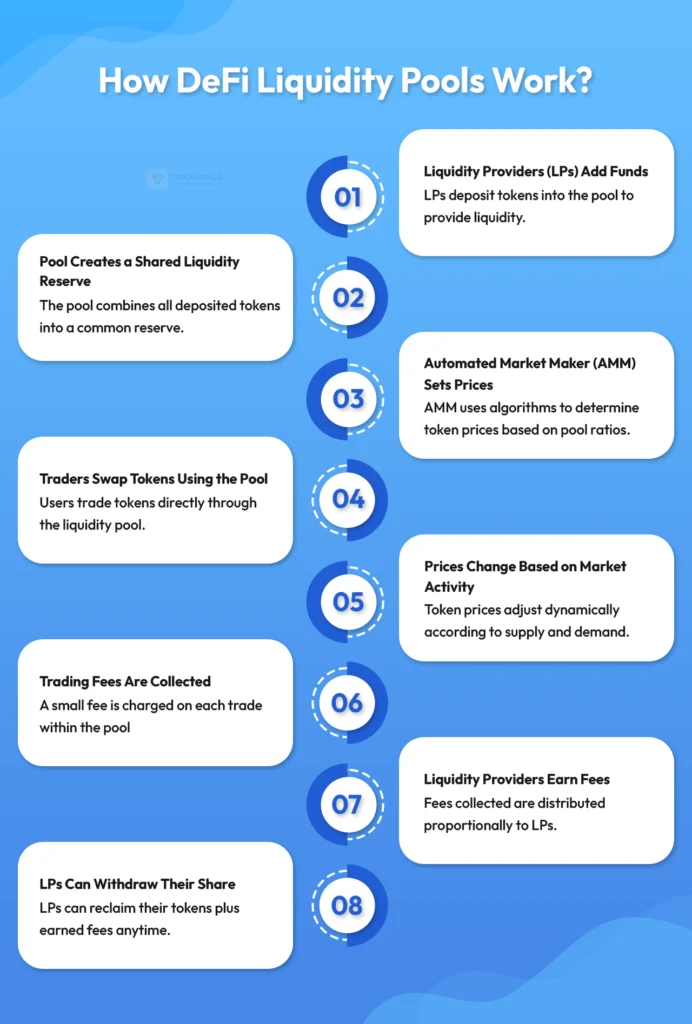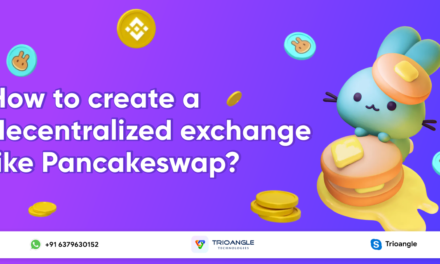Let’s take a look at the core component of decentralized finance: DeFi Liquidity Pools.
If you have ever used decentralized protocols like Uniswap, PancakeSwap, or others, you may have come across their liquidity pools—even without realizing it.
Some people may be familiar with liquidity pools, while others might wonder: “What are DeFi liquidity pools?” How do they work, and why are they needed in DeFi platforms?‘
In this blog, let’s explore everything about DeFi liquidity pools and how they help DeFi run smoothly.
So, let’s start by understanding the fundamentals. Let’s see…
What Does DeFi Liquidity Pools Mean?
Think of a DeFi liquidity pool as a token reservoir shared by users on decentralized platforms. Users deposit their crypto assets into this pot, which is controlled by smart contract code. Basically, it’s a collection of cryptocurrencies locked in a specific smart contract. These assets can then be used by others to trade, stake, and yield farm tokens directly through the pool.
Think, at centralized exchange platforms, trades are made using an order book. Buyers and sellers place their orders and wait for a match to occur. In contrast, DeFi liquidity pools allow users to trade directly and instantly without needing a matching order.
The users who supply assets to these pools are called liquidity providers (LPs). They deposit their tokens into the pool and earn a small fee every time someone makes a trade using the assets they provided.
Each liquidity pool typically contains a pair of cryptocurrencies, such as BTC/USDT. As supply and demand fluctuate, the price of the tokens adjusts in real time.
So,…
Why DeFi Liquidity Pools are Important in Decentralized Platforms
Decentralized finance functions automatically and lets anyone make transactions on their own. There is no central controller or single source of funding; instead, users provide funds into the platform’s liquidity pools. These funds inside the liquidity pools power the DeFi ecosystem and make decentralized trading possible for all users.
However, there should be sufficient liquidity in the pools to enable platforms to facilitate better, faster DeFi trades with minimal slippage.
Most decentralized exchange platforms are equipped with an Automated Market Maker (AMM). This algorithm uses the formula (x*y=k) to manage funds in DeFi liquidity pools and adjust prices depending on market conditions.
At the time of writing this article (Q2 of 2025), the reports from DefiLlama show that the total value locked (TVL) in the DeFi liquidity pools is approximately $111.8 billion. And, Uniswap alone handles more than $2 billion (approx) in trading volume weekly.
In short, DeFi liquidity pools are a vital factor that enables decentralized trading; they are like the engine behind it.
Now, let’s move forward and explore…
How DeFi Liquidity Pools Work?
Here’s an overview of how liquidity pools operate in decentralized finance.

1. Liquidity Providers (LPs) Add Funds
Users or liquidity providers deposit equal values of two different tokens into the pool. Let’s say a user has ETH and USDC; they need to add both tokens in equal value. For example, $1000 worth of ETH and $1000 worth of USDC are to be locked inside the pool.
2. Pool Creates Shared Liquidity Reserve
The tokens added by the users are gathered together, creating a liquidity reserve. With this, traders can swap tokens from this pool. Smart contracts hold and manage these assets.
3. Automated Market Maker (AMM) Sets Prices
Automated Market Makers (AMMs) apply the x*y=k formula to calculate token prices depending on the pool’s token balances. Here’s the breakdown of how this formula is calculated.
- “x” = amount of token A
- “y” = amount of token B
- “k” = constant (never changes)
Now, many of you might wonder and think what the term “constant” means here.
Let me make it simple.
No matter how many tokens get swapped, the product of the amounts of the two tokens in the pool is always equal; it is known as a constant.
For example, let’s say the pool has 10 ETH and 1000 USDT; the constant is 10 × 1000 = 10,000.
If someone buys 1 ETH, the ETH goes down to 9, so USDT must go up to about 1,111 to keep the total 10,000.
This is how the AMM keeps the liquidity pool balanced by automatically adjusting token amounts to maintain the constant value.
4. Traders Swap Tokens Using the Pool
When traders want to swap one token for another, they interact with the pool. It automatically calculates the exchange rates depending on the current token balances and executes the swap perfectly.
5. Price Change Based on Market Activity
Token prices fluctuate after every transaction due to changes in their ratio. This reflects market supply and demand in real-time.
6. Trading Fees Are Collected
Every time a user trades with the DeFi liquidity pool funds, a small fee is collected from the trader for using the funds.
7. Liquidity Providers Earn Fees
In return for providing funds, the liquidity providers are incentivized with the trading fees collected from the users.
8. LPs Can Withdraw Their Share
Liquidity providers (LPs) can withdraw their funds from the liquidity pools anytime, plus any extra tokens they earned from fees. Their withdrawal amount depends on the pool’s current token balances and total liquidity.
Now, you have explored the working mechanism behind the DeFi liquidity pools. Now, let’s continue by exploring the…
Types Of DeFi Liquidity Pools
Not all liquidity pools work in the same way, as many platforms evolve in the DeFi space, decentralized platforms bring more innovations to the liquidity pools. They do this with the intent to project themselves as a unique one in the highly crowded DeFi space.
So, here’s the list of some different DeFi liquidity pools.

1. Constant Product Pools
Some popular DEX platforms like Uniswap use this type of pool. DeFi liquidity pools employ the constant product formula x*y=k to stabilize token prices.
- You need to submit two tokens that hold the same value.
- As people trade, the value shifts, and the pool automatically adjusts its value by following this formula.
- This works best for general-purpose token trading and facilitates quick token swaps.
2. StableSwap Pools
This type of DeFi liquidity pool allows trading of stablecoins or tokens like USDC and DAI. It uses a modified formula that helps achieve efficient trades with lower slippage.
- It maintains a near 1:1 exchange rate between the assets, unless there’s a heavy imbalance.
- This system knows the tokens are supposed to be the same price, so it lets people trade between them without changing the price much.
3. Concentrated Liquidity Pools
Concentrated liquidity pools come in the Uniswap v3 model. With this pool, users or liquidity providers can choose specific price ranges where they want their funds to be active.
- Instead of spreading liquidity to all available prices, you can narrow down and set the preferred price. Think you establish a range beginning at $1000.
- When your asset trades $1000 or higher, it will be active. If the asset price goes down below $1000, it will not be used for trading.
- Your assets can be used when they reach your preferred trading price. This can increase users’ earnings for providing liquidity.
- This helps reduce losses and makes better use of your funds, since your tokens are only active where most trading happens.
4. Weighted Pools
The weighted pools come in the DeFi platforms like Balancer. Typically, liquidity pools require two tokens of the same value. But weighted pools are different.
- These pools let you set custom token weightings, like 80/20 or 60/20/20, instead of always 50/50.
- The system tries to balance the ratio of the tokens even in unexpected market shifts.
- It’s good for custom strategies, multiple token exposure, and DAO treasuries.
5. Meta Pools
Meta pools are a special kind of DeFi liquidity pool that can be added on top of the existing liquidity pools to enable different stablecoin trading. By leveraging the large liquidity of the original pool, meta pools enable smooth trading without needing direct pairs for every token.
For example, imagine there’s a big pool with stablecoins like USDT, USDC, and DAI. People use this pool to swap between these stablecoins easily.
Now, suppose a new token called “Jana” wants to join this pool. Instead of creating a brand-new pool just for “Jana”, a meta pool is created that connects “Jana” to the big stablecoin pool.
Related Article: The Role of Cross-Chain Communication in Enhancing DeFi Liquidity
DeFi Liquidity Pools and Decentralization: Why it’s Valuable?
DeFi liquidity pools are powerful—not just because of how they work, but because of what they stand for.
In our traditional finance, authorities control who can provide money, who can trade, and when. But with DeFi, anyone can provide assets into the liquidity pools, which helps for trading and earning commissions. No need for proof or identities to get started, just a mobile with an internet connection is enough.
DeFi liquidity pools run quietly in the background, but their impact is massive. They power decentralized trading and help the entire DeFi ecosystem work more efficiently.
Right, you have come across many topics now, it’s time to wrap up…
Wrapping Up
Now, you have covered the fundamental information of DeFi liquidity pools. You have explored what DeFi liquidity pools are, how they work, and other key insights.Iif you want more info about decentralized finance or DeFi business, then kindly SUBSCRIBE to the blog post. Be the first to know about the latest news, tips, and more about the DeFi business.
If you’re an entrepreneur or business owner looking to launch a DeFi platform, aim to design your liquidity pools in an innovative and robust way. This will make your platform stand out and more appealing to millions of DeFi users.
Now, many of you might think like:
“Where can I build DeFi solutions with robust liquidity pools?”
Trioangle is a smart choice, an industry-recognized firm. We offer a well-crafted decentralized exchange script, equipped with robust liquidity pools. With this, they help you build your DeFi solution more quickly.
Get Started With Our Well-crafted DEX Scripts








